Content
- 1 Walnut varieties for the Moscow region.
- 2 Which variety should you choose?
- 3 Ideal
- 4 Walnut. Variety Ideal: Video
- 5 Giant
- 6 Walnut. Variety Giant: Video
- 7 Walnut: description
- 8 How to plant a tree?
- 9 Popular varieties
- 10 Walnut: grade "ideal"
- 11 "Dessert"
- 12 Black walnut
- 13 "Elegant"
- 14 "Harvest"
- 15 "Abundant"
- 16 "Giant"
- 17 Walnut: large-fruited varieties
- 18 Giant varieties
- 19 "Kalarashsky"
- 20 "Memory of Minov"
- 21 Walnut Ideal, photo and description
- 22 Walnut Giant
- 23 Walnut varieties Graceful
- 24 Walnut Harvest
- 25 Walnut variety Aurora
- 26 Walnut variety Zarya Vostoka
- 27 Walnut Breeder
- 28 Tall walnut varieties for pollination, grafting and gardening
- 29 Ukrainian and Belarusian walnut varieties
Walnut is a heat-loving southern culture. However, thanks to the labors of breeders, frost-resistant, early-growing species have appeared, which are successfully grown in various regions of our country. On this page, you will get acquainted with the characteristics and descriptions of walnut varieties that will help you make the right choice.
Ideal is the most famous variety
The favorite of domestic gardeners, the Ideal variety takes 1st place among the best varieties of walnuts. Let's dwell on its merits in more detail.
- Firstly, high resistance to frost (the tree can withstand up to -36, buds up to -32).
- The second remarkable quality is its early maturity. Already in the 2nd year, the nut begins to bear its first fruits.
- This species is high-yielding. Under favorable conditions, a 10 -15 year old tree can yield up to 120 kg of fruit.
- Another advantage is short stature. Trees grow on average up to 5 m.
"Ideal" loves sunlight (the tree will ache in the shade) and space. Waterlogging is unacceptable. The place for the nut should not be in the lowlands, where moisture usually stagnates in spring or after rains. If the soil on the site is acidic, you need to add ash or lime to the hole.
In May, flowering begins, with male and female flowers blooming almost simultaneously, which is important for pollination. "Ideal" has proven itself perfectly in the middle lane and in the Moscow region.
Advantages:
• Resistant to severe frost
• Fast-growing
• Thin-bored fruits
Flaws: • Does not tolerate shading
• Powerful spreading roots (a sufficiently spacious planting area is needed).
Walnut varieties for the Moscow region.
Gardeners of the middle zone and the Moscow region are primarily interested in the winter hardiness of walnuts. Winter freezing of shoots is the main reason that hinders the spread of this culture in the northern regions. Below are descriptions of the most frost-resistant varieties of walnuts that tolerate our harsh winters relatively easily, and if they freeze, they quickly recover.
Giant
Giant
Variety "Giant" - frost-resistant (up to -33), drought-resistant. These are medium-sized trees, growing up to 6 meters, beginning to bear fruit in the 6th year. Flowering begins in May. By the beginning of October, fruits ripen (6-7 cm) in 2-3 pieces. together, thin. Nuts taste sweet with low fat content. Productivity by 15-16 years can be up to 40 kg.
Advantages:
• Winter hardy
• Large fruits with thin shells
• The core can be easily removed
• Good disease resistance
Flaws: • Relatively late fruiting
Sadko
Sadko
The undersized variety "Sadko" is remarkable.Mature trees barely reach 3.5 meters in height. This dwarf variety is highly winter-hardy and grows well in central Russia. The first harvest "Sadko" begins to bring in 3 years. Fruits ripen in clusters of 6-8 pieces. Nuts with a thin shell up to 4 cm in size. I would like to draw the attention of gardeners of the Moscow region to this variety, because it was created specifically for growing in the Moscow region.
Advantages of the variety: • Frost resistance
• Short stature
• early maturity
Astakhovsky
Astakhovsky
A new variety "Astakhovsky" - frost-resistant (up to -37 degrees) has proven itself well in the conditions of the Moscow region. Trees grow up to 10 meters. The first fruits begin to bear on the 6th year of growth. It blooms in early May. The harvest ripens by mid-September. One tree can give about 40 kg.
Advantages: • High frost resistance
• Excellent resistance to disease
• Early maturity
Flaws: • High crown
• Late entry into fruiting
Yielding
Yielding - a winter-hardy variety of walnut, has proven itself well in the Central Chernozem region and the Moscow region. The tree grows to a height of 6 meters. Fruiting in 4 years after planting. Flowering occurs in early May. Nuts ripen at the end of September. The yield is 25 kg. The kernel has a sweet taste.
Advantages: • Fast-growing
• Early maturity
• Annual fruiting
Flaws: • Medium disease resistance
• Tall tree with wide oval crown
Levina's early-growing walnut
A variety with excellent frost resistance (up to -35) can be grown in the middle lane and the Moscow region. Low-growing trees give a harvest already in the 4th year. Fruits 5-6 cm in size ripen in 4-6 pieces. in a bunch. Productivity 15-20 kg per tree. The very thin "paper" shell is easily crushed by fingers.
Advantages:
• Resistant to severe frost
• Large-fruited
• Excellent resistance to disease
• Kernels are easy to extract
Review of varieties of walnuts for the Krasnodar Territory
The market offers a wide variety of species of this crop, zoned for cultivation in the Kuban. Below are the best varieties that have already proven themselves well.
Aurora
Aurora
A fast-growing frost-resistant form with the beginning of fruiting in the fourth year. The height of the trees reaches 6 m. Diseases are slightly affected. Bloom in late April. You can start picking nuts from mid-September. Productivity is about 25 kg. The variety is zoned in the Krasnodar Territory.
Advantages:
• Stable yields
• Thin-bored fruits
• Disease resistant
Flaws: • Vigorous
Walnut variety Zarya Vostoka
Dawn of the East
A species with sufficient winter hardiness. Medium-sized trees with a compact crown. Fruiting from 4-5 years. Brown spot damage is moderate. This variety of walnut has apical - lateral fruiting. The tree blooms at the end of April, and in mid-September, nuts are already ripening. Productivity 24 kg. It has proven itself well in the conditions of the Krasnodar Territory.
Advantages: • Early maturing
• Regular fruiting
• Thin shell
Flaws: • Low resistance to disease
Walnut variety Graceful
Elegant
Trees of this species grow up to 5 meters with a dense leafy crown. It enters the fruiting phase in the 4th year. The winter hardiness of the variety is average; in severe frosts, wood and flower buds can be damaged. Practically not susceptible to fungal diseases. By the end of September, it produces about 20 kg of fruits with high palatability.
Advantages:
• Resistant to brown spot and pests
• Excellent taste
• Drought resistant
Flaws: • Possible frost damage to bark and kidneys
Walnut Five Years
Walnut with an interesting name Five Years
A vigorous, early-growing variety of walnut with satisfactory frost resistance.Recommended for cultivation in the southern regions. Fruiting 4 years after planting. Blooms late to mid-May. The nuts are ready to be harvested at the end of September. The harvest is 20 kg.
Advantages:
- Disease resistant
- Drought tolerant
Flaws:
- Vigorous trees
Breeder
Breeder
Medium-sized form with the beginning of fruiting at 4 years. The frost resistance of the variety is average. It is slightly damaged by diseases. Flowering occurs at the end of April. The type of fruiting is predominantly apical. At the beginning of September, the crop is ready to be harvested. One walnut tree gives about 20 kg. A promising variety for the Krasnodar Territory.
Advantages:
• Fast-growing
• Thin shell
• Amicable ripening of nuts
Abundant
Walnut Abundant
Trees reach a height of 5 m. Fruiting begins in the 4th year. Poorly tolerates frost, but has good resistance to brown spotting. Recommended for cultivation in the southern regions (Krasnodar Territory, Adygea). Fruits of this species are collected in bunches of 8 pieces each. Productivity 28 kg.
Advantages:
• Fast-growing
• Yielding
• Wonderful taste
Dessert
Dessert
Vigorous trees with a spreading crown. In the 4th year of growth, they begin to bear fruit. Low frost resistance. Bloom in late April. Fruit picking in mid-September. Yield 22-25 kg of nuts. This walnut variety is zoned in the Krasnodar Territory.
Advantages:
• Fast-growing
• Resistant to brown spot
• Early maturing
Krasnodarets
Krasnodarets variety
A tree of strong growth with a dense crown. Fruiting in the 4th-5th year. Average frost resistance. Flowering begins by the end of April. Ripening of the crop at the end of September. You can collect 18-20 kg from a tree. Even the name of this variety suggests that it is zoned for the Kuban.
Advantages:
• Disease resistant
• Large and tasty fruits
• Drought resistant
Petrosyan's favorite
Petrosyan's favorite
A fast-growing variety of walnut. The trees are vigorous with a rounded crown. At 4-5 years of development, it bears the first fruits. Frost resistance is good enough. Early flowering - at the end of April, with male and female flowers blooming at the same time. The fruits ripen at the end of September. The harvest is 22 kg per tree. Recommended for cultivation in the regions of the North Caucasus.
Advantages:
• Fast-growing
• Drought resistant
• Excellent fruit taste
Pelan
Pelan variety
This variety of walnut has tall trees with sufficient frost resistance. "Pelan" begins to bear fruit in 4-5 years. Bloom in late April. The crop can be harvested at the end of September. Average yield 25 kg per plant. The variety is recommended for cultivation in the Krasnodar Territory and other regions of the North Caucasus.
Advantages:
• Fast-growing
• Early maturing
• Fruits with a thin shell
• Annual stable yields
How to grow walnuts from fruits
Save article to:
Dear visitors of the "Dacha Plot", tireless gardeners, gardeners and flower growers. We offer you to pass the aptitude test and find out whether you can trust the shovel and let you into the garden with it.
Test - "What kind of summer resident I am"
Share this article with your friends:
Walnut varieties are currently available in a wide range. All of them differ among themselves in their characteristics - some give a greater volume of yield, others are more pleasant to the taste.
In addition, there are also varieties of walnuts that are resistant to diseases, low temperatures and harmful insects. This option is more relevant for the middle zone, where frosts are quite frequent, as well as for those who decided to start growing nuts for the first time.
The fact is that nuts are not only a whole piggy bank of vitamins and other useful substances, but also a source of stable high income.True, the first fruits have to wait about four years, and trees begin to bear fruit in full only after decades. It is for this reason that the option of such a business is not suitable for every person. first you need to have some funds that will pay off only after years.
If you nevertheless decided to do this, then it is better to study all the available varieties of nuts, and only then make a choice in favor of this or that variety, taking into account all its features.
Which variety should you choose?
Of course, people strive to get the best. We will consider the best varieties of walnuts in this article, after which you will only have to choose which one is suitable for your purposes.
Ideal
The ideal walnut has gained quite high popularity among gardeners in Russia. The main feature of this variety is that it can withstand temperatures as low as minus 35 degrees.
The seeds of the ideal are planted in the autumn in pits of 10 centimeters. By the beginning of summer, you can already see the appearance of the first shoots. For several months, they grow by 13-15 centimeters. Due to its frost resistance, grown seedlings do not need to be covered for the winter. Already during the second year, the nut grows more than a meter in height and begins to bear fruit for the first time. Growth and fertility will only increase every year.
Try not to let the walnut shade, because he needs an abundance of sunlight. It is better to plant away from buildings, because the ideal has rather powerful roots that grow not only in depth, but also to the sides. In May, flowering begins, and by mid-autumn the fruits are already ripening. A tree of this type is not tall, about five meters tall. The ideal bears fruit twice a year, and the kernels have a fairly pleasant taste. More than a hundred kilograms of nuts are harvested from mature trees every year.
Reproduction of ideal varieties is possible only from seeds, and all qualities are fully preserved.
Walnut. Variety Ideal: Video
Giant
The giant walnut saplings are also noteworthy. In fact, they are the second most fruitful variety, occupying their niche immediately after the Ideal variety. After planting, the tree takes about five years before it begins to bear its first fruits.
The growth of the "Giant" is quite fast, and the trees reach a height of five meters. At the same time, the tree has a fairly wide, dense and spreading crown, which allows you to pleasantly while away a summer day under it, for example, reading your favorite book. It is possible to plant the “Giant” variety in any region, because this nut is unpretentious. Of course, in the first time after planting, abundant watering is required; you can additionally spray the tree with a hose in very hot weather.
The fruits of this variety are round in shape, rather large. From each tree, you can collect about a centner of nuts annually, which is quite good, given the thinness of their shell. The "Giant" has excellent resistance to various diseases.
You can also grow Cardinal walnuts. In terms of fruiting, it is slightly inferior to the varieties described above, but at the same time it is also unpretentious and suitable for growing in most regions of Russia.
Walnut. Variety Giant: Video
The taste and useful properties of these wonderful fruits are probably known to all our readers. Do you know which varieties of walnuts are distinguished by winter hardiness, high productivity, resistance to pests and diseases, and excellent fruit quality? We will tell you about this in this article.
Walnut: description
Many have seen this powerful deciduous tree. It has a developed root system. The fruits of this tree are dry drupes with fleshy inedible plyus. They dry out and crack when ripe. In terms of size, the fruits are small, large or medium.Their shape depends on the type of tree - round, oval, oval-oblong, oblong-squeezed from the sides, ovoid, etc.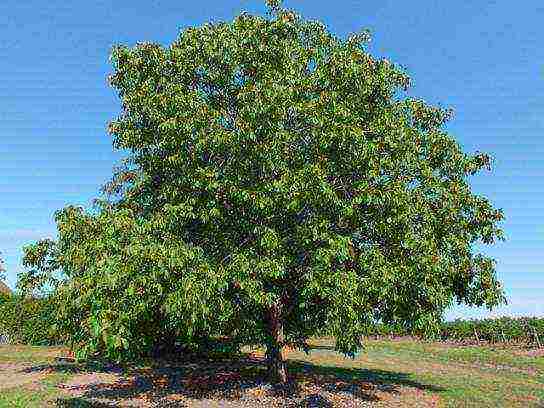
The shell has an almost smooth, finely and coarsely wrinkled, sometimes lumpy surface with numerous cells. All varieties of walnuts are both moisture- and heat-loving crops, capable of developing and producing crops only in warm, southern regions, prefer moist lands. The nut grows and develops well where the average annual air temperature is not less than +10 ° С, and in the warmest month the air warms up to +25 ° С. That is why in the middle lane most of the walnut fruits do not have time to ripen.
Today, there are many varieties and varieties of this tree, which are resistant to light frosts and diseases and have a pleasant taste. Many of them yield excellent harvests.
How to plant a tree?
Descriptions of walnut varieties today can be found in all gardening publications, so every summer resident can try to grow this tree on his site. Any soil is suitable for him. It is important to dig a hole, the depth of which will be at least a meter, and the diameter is about fifty centimeters. Place the seedlings in water for two days before moving them into the hole. If you do everything right, in three to four years the tree will delight you with its first harvest.
Popular varieties
Gardeners of our country note several varieties that are in high demand and are considered the best. They are selected according to several criteria. Nuts with a thin shell and a large round shape are of particular value.
Today, 21 varieties of walnuts are cultivated on the territory of our country. However, some of them are grown more often than others. These include, first of all, such varieties as "ideal" and "giant". We will tell you more about them below. In regions of Russia where winter is not too harsh, early-growing forms are planted, which were obtained by breeders from the Tashkent region.
Walnut: grade "ideal"
In the fifties of the last century, S. Kalmykov, a breeder from Fergana, bred a new variety of early-growing walnut. It begins to bear fruit in the fifth year. Walnut ("ideal" variety) has inflorescences that form a brush, on which several nuts appear at once. The main feature of this variety is the possibility of a second flowering with many nut ovaries.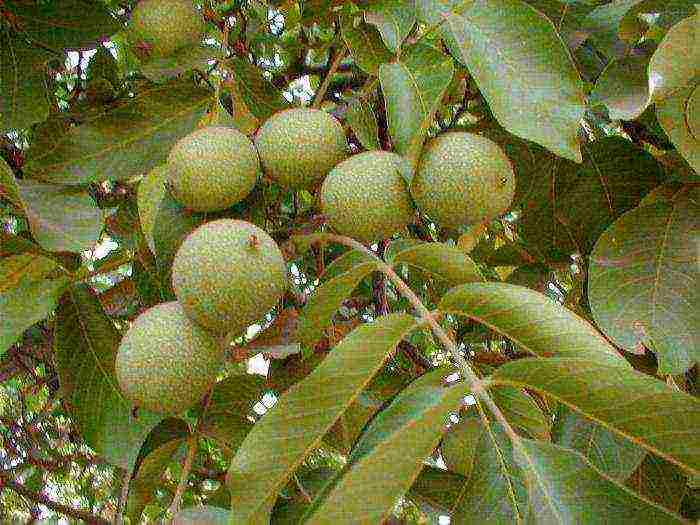
By the time this variety was received, a series of articles about early-growing nuts bred in Fergana had appeared in magazines. Many varieties of S. S. Kalmykov began to bear fruit at the age of two. They were undersized (no more than 2 m), while 10-18 fruits were tied in the brush. These articles caused a furor among gardeners. The famous breeder began to receive letters from all over the Soviet Union.
Quite a large walnut of the "ideal" variety has won recognition among Russian gardeners for its high frost resistance. It can withstand frosts down to -35 degrees. Seeds are planted in the fall in the ground to a depth of 10 centimeters. At the end of June (next year), the first shoots appear, and by autumn the seedling grows to fifty centimeters. It is important that there is no need to cover young trees for the winter.
"Ideal" needs an abundance of sunlight, it does not tolerate shading well. The tree develops and grows well on loamy calcareous soils, moderately moist. The tree has a strong, wide root system, so the nut should be planted away from various buildings. Flowering begins in May, fruits can be harvested at the end of September. The flowers are collected in inflorescences, from which clusters of nuts are formed.
After three years, the nut begins to bear fruit. Growing up, the tree increases its yield. It grows to an average of five meters. It has a good harvest (120 kg). These numbers refer to an adult plant (12 years old). The mass of the nuclei is on average 10-12 grams.
"Dessert"
The varieties of walnuts that are in demand in our country today are also adequately represented by the early ripening "dessert" variety. It is a medium-sized tree (3 meters high) with a spreading crown.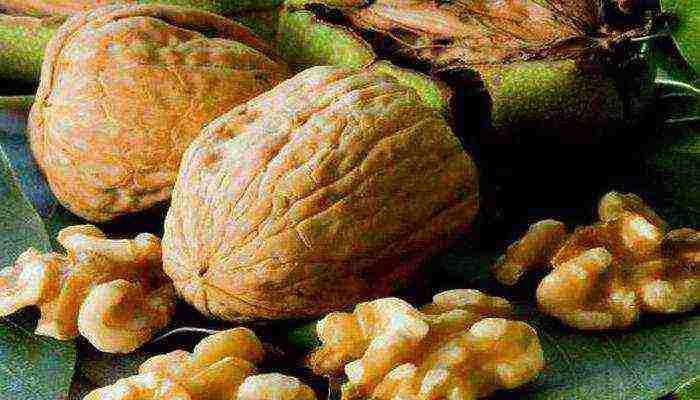
The variety is resistant to drought, the tree bears fruit sweetish in taste in a powerful shell. This variety is intended for cultivation in the south of our country, because in severe frosts, flower buds and wood of a tree are affected. In the fourth year after planting, the tree begins to bear fruit. This variety is distinguished by stable and abundant yields. The fruits ripen in mid-September. On average, up to 25 kg of nuts are removed from one tree. The mass of the nuclei is up to 15 grams. This variety can be classified as large-fruited.
Black walnut
It is a wind-pollinated monoecious plant. The height of the tree reaches fifty meters. The length of cirrus leaves reaches forty centimeters and a width of twenty centimeters. They have a pronounced balsamic scent. Such a tree bears fruit in the tenth year.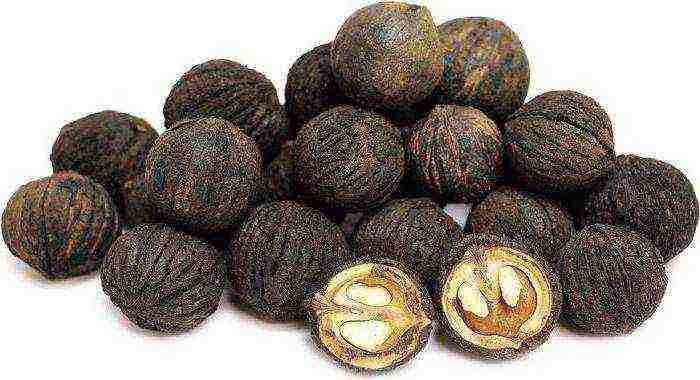
The fruit of a black walnut is covered with a thick, durable peel. They are larger than traditional ones, and their core is much darker, and has numerous grooves. Black walnut peel is rich in vitamins (especially vitamin C).
The kernel of the black walnut contains proteins, carbohydrates and oils. The leaves of this tree and the pericarp are used in the manufacture of some medicines (in particular for dietary supplements).
Black walnut is a light-loving plant. It is not particularly demanding for heat. This is a winter-hardy variety, however, in the first years after planting, the plant is sensitive to frost. Therefore, it is recommended to cover it at this time. Black walnut tolerates excessive moisture well, withstands flooding of the soil for 1.5 months.
The soil for this variety is preferable to be neutral or slightly alkaline. It should be mulched and loose. The tree needs protection from the wind.
"Elegant"
Walnut varieties, photos of which you can see in this article, ripen at different times. "Graceful" refers to the mid-early, as it bears fruit at the end of September. The tree reaches a height of five meters, has a powerful structure and a dense, well-leafy crown.
The characteristic features of this species are drought resistance and natural immunity to many diseases and pests. The plant tolerates frost moderately: wood and flower buds are affected only in severe frosts.
The first crop appears in the fifth year. One tree gives more than twenty kilograms of fruit, with good taste. The core weight is 11 grams.
"Harvest"
This is a fairly tall tree (up to 6 meters in height), has a wide-oval crown. Fruiting usually begins in the fourth year. The variety belongs to the mid-season, since the nuts ripen at the end of September.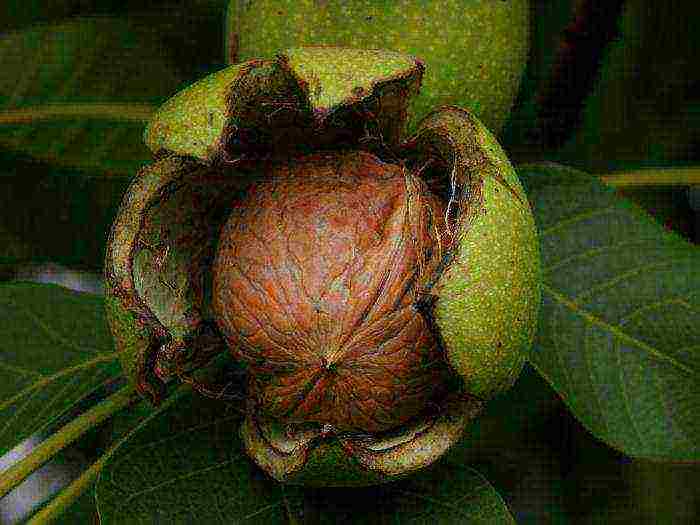
The variety is winter-hardy and slightly susceptible to brown spot and other diseases. Differs in good regular productivity. About thirty kilograms of fruits are harvested from one tree. The kernel with a great taste, weighing 9-11 grams.
"Abundant"
Some varieties of walnuts begin to bear fruit as early as the fourth year. An example of this is "abundant." The tree has a maximum height of five meters. This variety does not tolerate negative temperatures well, so it should not be planted in the northern regions of the country. It should be noted that it is resistant to a very common disease - brown spot.
Nuts are formed in clusters - 3 fruits each. Sometimes the bunch is eight or more nuts. The tree has a high yield - up to 30 kilograms of nuts with a kernel weight of 12 grams. This variety is very popular with gardeners because of its excellent taste.
"Giant"
The "giant" walnut is a bit similar to the "ideal", but the fruiting of this tree occurs in the sixth year. The tree grows surprisingly fast and reaches a height of five meters. It has a lush crown, rounded large fruits (10 grams).It produces a crop regularly, mainly on the apical branches. About one hundred kilograms of fruits with a thin shell are harvested from the tree. The plant is resistant to many diseases that are characteristic of walnuts (for example, brown spot).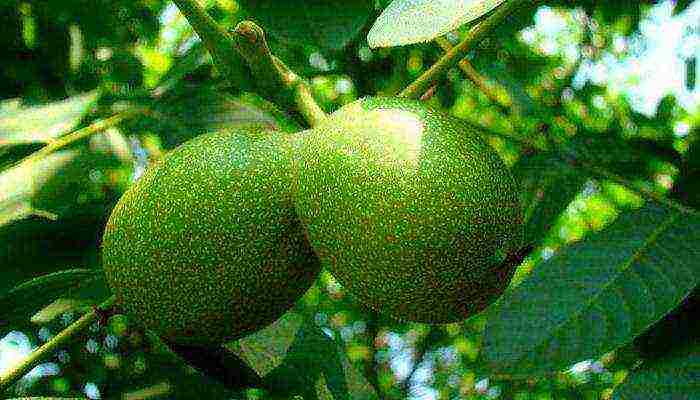
Walnut: large-fruited varieties
There are much fewer such varieties, which is probably why they are of particular interest to breeders. We have already told you about the varieties "ideal" and "dessert", which can be fully attributed to large-fruited.
Giant varieties
According to experts, one of the largest varieties is the “bomb” variety (Moldova). Its fruits weigh thirty grams. Thanks to its thick peel, such a fruit looks much more than its true weight - two nuts can hardly fit into a standard 250-gram glass.
Now scientists are working on its selection. Other interesting varieties have also been bred - "Rudakovsky", "Prykarpatsky", "Bukovinsky 2". There was even a variety that was called "Bukovina bomb". There is clearly a hint of the size of the Moldovan nut.
The fruits of the new varieties bred in Ukraine are smaller - their weight does not exceed twenty grams. The good frost-resistant varieties "Stanislavsky" and "Tula Tonkokory" should also be noted. They produce nuts weighing over fifteen grams.
"Kalarashsky"
Walnut varieties are becoming popular not only because of the size of the fruit. The taste of the product is of no less importance.
It is a vigorous tree with a dense, rounded crown. Blooms early enough. Has a proterandric type of flowering. This means that staminate flowers bloom about seven days earlier than pistillate ones. For this tree, the best pollinator is the Skinos variety.
The nuts are very large. The average fruit weight reaches nineteen grams. The shape is round, slightly ribbed, with a rounded top and a flat base. The shell is not very thin, dense. The kernel is large; when the nut is broken, it separates completely. The core film is yellow. The kernel is oily, with a pleasant taste.
"Memory of Minov"
Not all large-fruited varieties of walnuts are widespread in our country. For example, this is an excellent medium-ripening variety. It belongs to the large-fruited variety of the nut.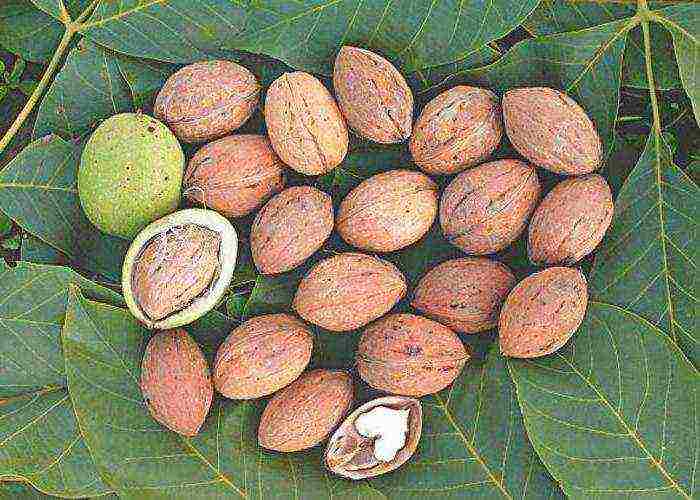
The tree grows rapidly, it is powerful, with a crown of medium density. Flowering is homogamous. The fruits ripen mainly on the apical branches. Fruiting is regular, occurs in the sixth year after planting. Walnut large-fruited variety "Memory of Minova" is very large, slightly flattened, slightly ribbed. The average mass of the nucleus is 15.2 grams, the maximum is 18.5 grams. The nut has a thin shell, its thickness is 1.0 mm. This variety belongs to the table types.
We have presented you the best varieties of walnuts. Of course, this is not a complete list. Anyone who is interested in these plants and their fruits, we recommend that you look through publications on gardening, where descriptions of new products from Russian and foreign breeders are regularly published.
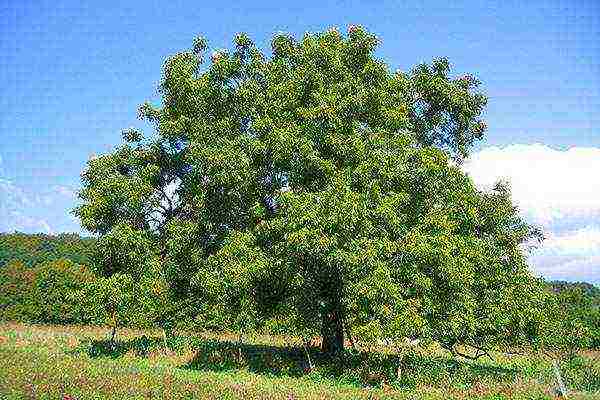 Walnut is a valuable crop that is massively grown in Central Asia and Ukraine, southern Russia, Moldova and Belarus. Back in the days of the USSR, numerous varieties of walnuts with high yields, excellent frost resistance and a non-capricious disposition were obtained and have proven themselves well. Today, breeders from different countries continue this work, so the range of varieties interesting for gardeners has expanded significantly.
Walnut is a valuable crop that is massively grown in Central Asia and Ukraine, southern Russia, Moldova and Belarus. Back in the days of the USSR, numerous varieties of walnuts with high yields, excellent frost resistance and a non-capricious disposition were obtained and have proven themselves well. Today, breeders from different countries continue this work, so the range of varieties interesting for gardeners has expanded significantly.
Walnut Ideal, photo and description
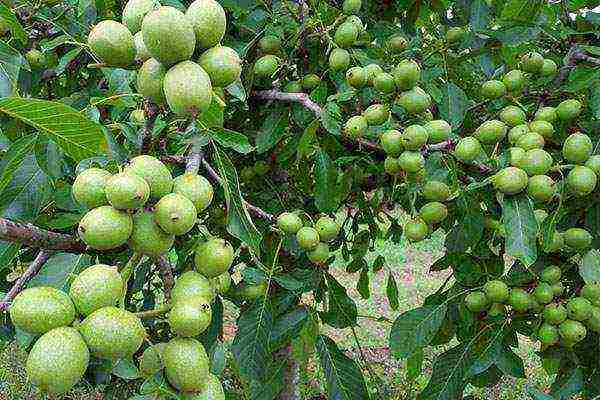 Among the Russian varieties of walnuts, there are many worthy ones, but only Ideal was able to conquer the gardens of the Black Earth Zone, the regions of the Middle and Lower Volga, and even some areas of the Non-Black Earth Region. The reason for this popularity is its excellent resistance to cold, the compactness of the crown, which does not grow higher than 5 meters, as well as the quick return of the crop. As you can see in the photo, the Ideal walnut begins to bear fruit already in the first or second year after planting the seedling in the ground.
Among the Russian varieties of walnuts, there are many worthy ones, but only Ideal was able to conquer the gardens of the Black Earth Zone, the regions of the Middle and Lower Volga, and even some areas of the Non-Black Earth Region. The reason for this popularity is its excellent resistance to cold, the compactness of the crown, which does not grow higher than 5 meters, as well as the quick return of the crop. As you can see in the photo, the Ideal walnut begins to bear fruit already in the first or second year after planting the seedling in the ground.
Walnut Ideal tolerates frosts up to 30–35 ° C.Winter is well tolerated not only by the bark and perennial wood, but also by the shoots of the last year.
If a cold snap can damage this variety, then in the spring during return frosts. In this case, the situation is saved by prolonged repeated flowering, which compensates for the loss of flower buds that opened in May.
Combined in a brush, smooth oval nuts weighing 10-12 grams are harvested from mid-September. The large kernel accounts for more than half the weight. The shell of this walnut variety is thin, easily detachable from the kernel.
Walnut Giant
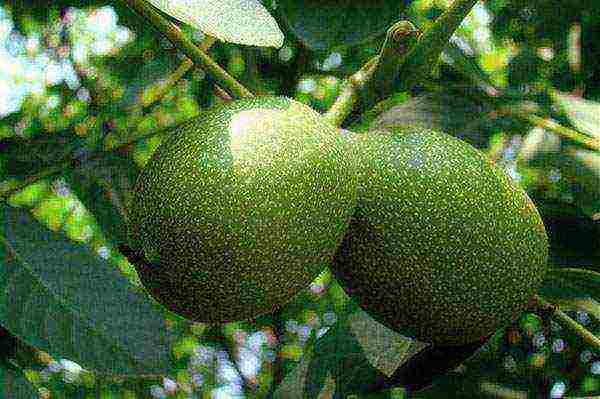 Another popular variety among Russian gardeners is the Velikan walnut, named for its really large fruits, which can weigh up to 35 grams. In terms of yield, this crop is close to the previous variety. The trees are also quite compact, and their spreading crown does not exceed 5-7 meters in height.
Another popular variety among Russian gardeners is the Velikan walnut, named for its really large fruits, which can weigh up to 35 grams. In terms of yield, this crop is close to the previous variety. The trees are also quite compact, and their spreading crown does not exceed 5-7 meters in height.
The Giant variety is resistant to common diseases of the walnut, is not afraid of the harsh Russian winters and bears excellent fruit with moderate moisture and nutritional value of the soil.
Walnut variety Graceful
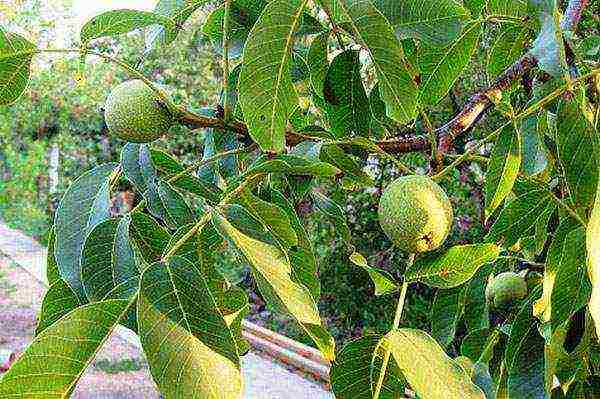 To get a harvest of nuts for gardeners of the middle lane is hindered by the long growing season of the plant and its fear of cold weather.
To get a harvest of nuts for gardeners of the middle lane is hindered by the long growing season of the plant and its fear of cold weather.
Thanks to the work of breeders, varieties have appeared that solve both these problems. These early ripening, unpretentious varieties include the Graceful walnut, whose fruits of excellent quality and sweetish taste are ready for harvest in mid-September. Moreover, the trees:
- are not afraid of drought and common diseases;
- rarely affected by pests;
- well leafy crown up to 5 meters high is easily maintained in a private garden.
However, with a high yield, reaching 20 kg per tree, the plants do not survive frosts well, during which the buds are affected, skeletal branches and trunk suffer.
Walnut Harvest
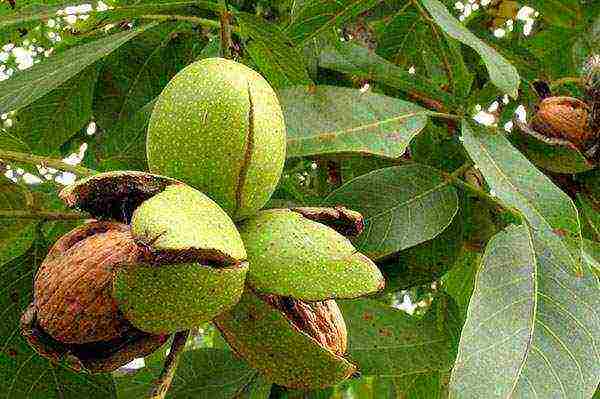 Trees of this variety grow up to 6 meters in height, are unpretentious to growing conditions and winter well even in harsh conditions. The Harvest walnut got its name due to its excellent fertility. Already from the fourth year of life, plants are capable of producing from 10 kg of selected nuts weighing more than 10 grams. Their collection begins in mid-September and, depending on the region of planting, ends towards the end of October.
Trees of this variety grow up to 6 meters in height, are unpretentious to growing conditions and winter well even in harsh conditions. The Harvest walnut got its name due to its excellent fertility. Already from the fourth year of life, plants are capable of producing from 10 kg of selected nuts weighing more than 10 grams. Their collection begins in mid-September and, depending on the region of planting, ends towards the end of October.
Walnut variety Aurora
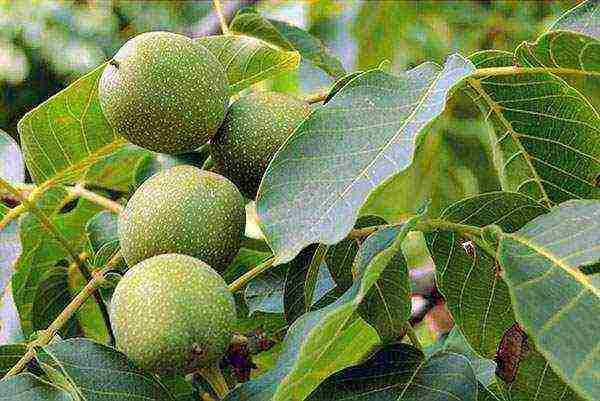 Among the early-ripening varieties resistant to frost and diseases, the Aurora walnut enjoys increased attention of gardeners. Unlike the Ideal or the Giant, these trees are much more powerful and taller. The first ovaries appear on plants at the age of four, and as they mature, plantings give larger and better yields. On average, the mass of a nut reaches 12 grams, the kernel with a good table taste makes up more than 50% of the mass.
Among the early-ripening varieties resistant to frost and diseases, the Aurora walnut enjoys increased attention of gardeners. Unlike the Ideal or the Giant, these trees are much more powerful and taller. The first ovaries appear on plants at the age of four, and as they mature, plantings give larger and better yields. On average, the mass of a nut reaches 12 grams, the kernel with a good table taste makes up more than 50% of the mass.
Walnut variety Zarya Vostoka
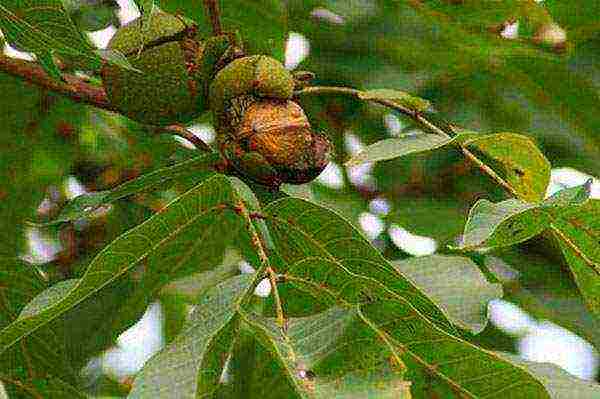 Another undersized walnut, quickly entering the fruiting season, forms a crown 3-4 meters high. Although nuts of the Zarya Vostoka variety cannot be called large, their weight is 9-10 grams, the culture pleases with yields of up to 25 kg per tree.
Another undersized walnut, quickly entering the fruiting season, forms a crown 3-4 meters high. Although nuts of the Zarya Vostoka variety cannot be called large, their weight is 9-10 grams, the culture pleases with yields of up to 25 kg per tree.
Walnut Breeder
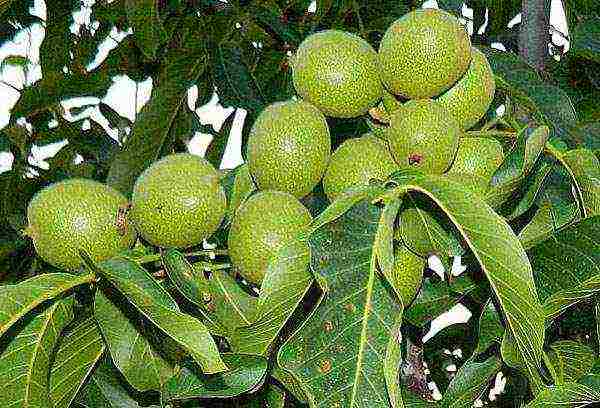 Slightly less, about 20 kg of walnuts, is provided by the Breeder variety. The culture oriented to the southern regions is characterized by stable, annual fruiting with a predominantly crown location of the ovaries. Despite the resistance to diseases and pests, the plants do not tolerate frost well. After a harsh winter, not only the buds suffer, but also the perennial wood, the bark of skeletal branches and the trunk.
Slightly less, about 20 kg of walnuts, is provided by the Breeder variety. The culture oriented to the southern regions is characterized by stable, annual fruiting with a predominantly crown location of the ovaries. Despite the resistance to diseases and pests, the plants do not tolerate frost well. After a harsh winter, not only the buds suffer, but also the perennial wood, the bark of skeletal branches and the trunk.
Tall walnut varieties for pollination, grafting and gardening
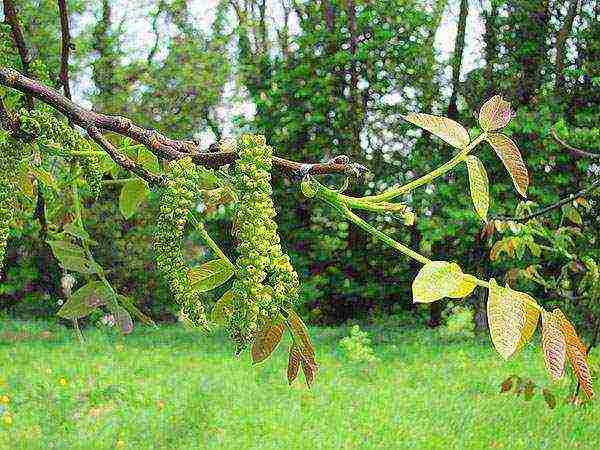
Since most walnut varieties are fully or partially self-sterile, they need pollinators.
As such plants, breeders offer varieties:
- Spectrum with up to 14 meters high winter-hardy trees and heavily ribbed large nuts;
- Orion, also reaching 16 meters in height and producing 11 gram egg-shaped nuts with a light shell;
- Marion, equally tall and powerful, yields 12g thick-shelled nuts.
These varieties of walnuts are often used not only as pollinators, but also as strong rootstock, and also, thanks to the powerful, excellent leafy crown, for landscaping.
Ukrainian and Belarusian walnut varieties
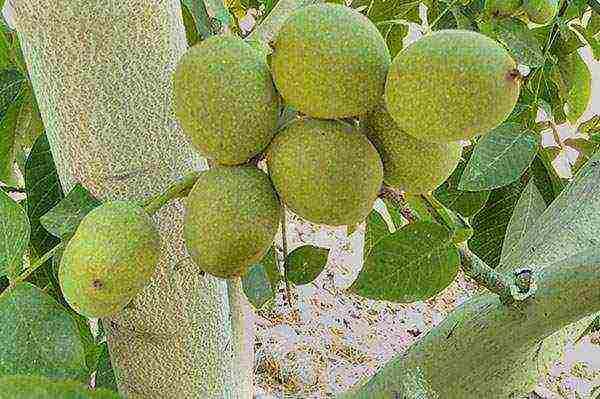 In the south of Russia and in Ukraine, varieties of Ukrainian selection are cultivated. These varieties include:
In the south of Russia and in Ukraine, varieties of Ukrainian selection are cultivated. These varieties include:
- Bukovinsky 1 and 2;
- Bukovina Bomb;
- Carpathian;
- Transnistrian and more than a dozen interesting fruitful varieties with medium or large nuts.
Recently, scientists of Belarus have been closely engaged in the selection of walnuts. The most famous of their varieties is the Memory of Minova walnut.
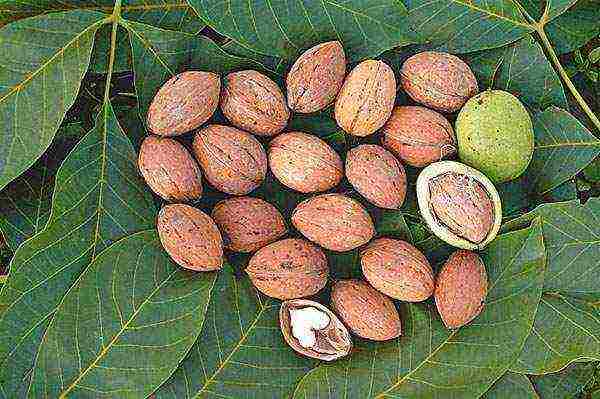 This variety, which underwent variety trials 15 years ago, belongs to large-fruited. The ovary forms on powerful large trees annually, mainly on the tops of the shoots. For the first time, fruiting from this variety should be expected 6 years after planting. Harvesting takes place in the second half of September.
This variety, which underwent variety trials 15 years ago, belongs to large-fruited. The ovary forms on powerful large trees annually, mainly on the tops of the shoots. For the first time, fruiting from this variety should be expected 6 years after planting. Harvesting takes place in the second half of September.
The further south the walnut is grown, the taller varieties are used by gardeners. For example, in Moldovan gardens, trees are not rare, reaching a height of 20-25 meters. But even these local plants are far from the powerful black walnut native to North America, which grows up to 40 meters in height.
 This culture is more and more interesting for gardeners who know about the beneficial properties of the fruits of this tree and the decorative qualities of its wood. Despite the similarity in appearance, walnut and black walnut are two different species with different characteristics and agricultural techniques.
This culture is more and more interesting for gardeners who know about the beneficial properties of the fruits of this tree and the decorative qualities of its wood. Despite the similarity in appearance, walnut and black walnut are two different species with different characteristics and agricultural techniques.
Video about a young walnut garden


